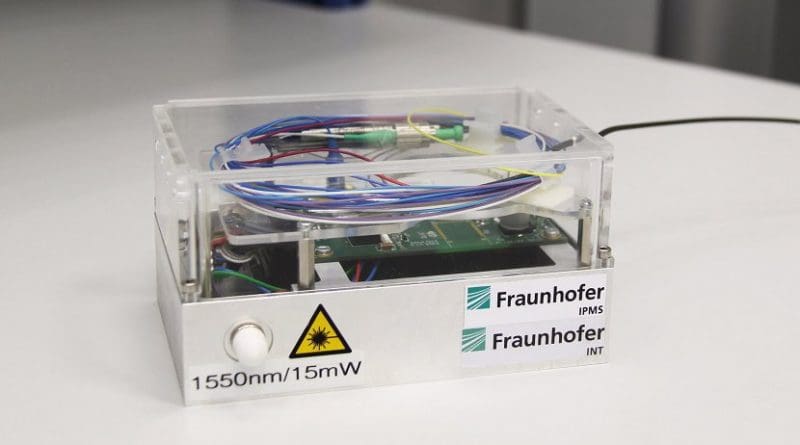Smart Alarm System Recognizes Attempted Break-Ins
There is a huge selection of glass break detectors on the market. Although these detectors reliably trigger an alarm when window panes break, they do not register all other ways in which burglars can interfere with a pane. To counter this, Fraunhofer researchers have created a new type of alarm system that recognizes any attempt to manipulate the window. It registers temperature changes in real time as well as vibrations caused by external interference with the glass, leaving burglars with no chance.
The window panes of jewelry stores, art galleries and banks are protected by alarm and fitted with security glass. However, the pane or part thereof has to break before the alarm is triggered. Conventional security glass contains metal threads that tear in the event of mechanical damage, activating the alarm. If a cutting torch or a drill is used to damage the glass, conventional systems react either too late or not at all. Burglars exploit this weakness and use a drill or a blowtorch instead of a hammer. Researchers at the Fraunhofer Institute for Technological Trend Analysis INT and the Fraunhofer Institute for Photonic Microsystems IPMS have jointly developed a smart anti-burglary protection system that overcomes this problem. The new system quickly and dynamically records thermal and mechanical stresses from external causes. Even a gentle knock against the security glass or manipulation through the use of a flame is enough to trigger the alarm. The external force applied to the pane changes its mechanical characteristics, and the system detects this change. This method of monitoring glass panes is based on a glass break sensor built inside an optical fiber by means of fiber Bragg grating, that is, optical interference filters inscribed in optical waveguides. The fiber optics can be fitted in the corner of the windowpane or in other positions.
Light-assisted surveillance of glass panes
The sensor with the fiber Bragg grating is an optical sensor, which reflects a specific wavelength of light that is changed by deviations in temperature and/or elongation. “If somebody exercises pressure on the glass pane or heats it, the distance between the grating elements changes, which in turn alters the transmitted wavelength. Sensitive optical measuring devices are capable of recording these changes. If the changes are greater than a predefined threshold, signals are transmitted to the alarm system,” says Udo Weinand, engineer at Fraunhofer INT, explaining the functioning of this patented system. “We can adjust our system in a very fine-tuned, targeted manner. It can react to slight knocks and to strong ones. As a result, it can be adapted individually to the specific application,” adds Dr. Peter Reinig, scientist at Fraunhofer IPMS.
The innovative break-in protection consists of a Bragg grating, a fiber optic supply cable, an interface to the alarm system, and evaluation electronics, which contain the optical measuring device. In future, the evaluation unit, to which various fiber optics can be connected, is to be fitted in the window frames. In high-security zones, the evaluation unit can be located far away from the security glass. “Measurement with fiber optic sensors is a good solution for these requirements, because it uses light instead of electricity and widely available fiber optics instead of copper wires,” says Weinand.
Pattern recognition avoids false alarms
Another advantage of the Fraunhofer system is that fiber optics are resistant to electromagnetic interference. Electronics can be disturbed by things such as microwave emissions, whose pulses can incapacitate conventional alarm systems or cause an unwanted alarm. In addition, pattern recognition rules out the potential for false alarms triggered by everyday vibrations. “A football or a bird leave behind a different signature than a hammer or a baseball bat,” notes Reinig. The smart alarm system was rigorously tested in various attack scenarios on a wide range of different security glass panes involving hammers, baseball bats, drills, firearms, axes and heat guns to determine when the alarm is reliably triggered.
The effectiveness of the sensor with fiber Bragg grating has been demonstrated in numerous tests, including the VdS test by VdS Schadenverhütung GmbH in Cologne. The independent, notified and accredited testing and certification institute for fire protection and burglary prevention issues the VdS seal of approval, a well-known distinction in German industry.
The burglary protection system created by Fraunhofer researchers currently exists as a demonstrator. Measuring only 14x9x7 cm³, the evaluation electronics is a small box that can be further miniaturized if required. The system is able not only to protect jewelry stores and other objects liable to be burgled, but is also suitable for monitoring bridges, buildings, pipes, load-bearing structures in the aerospace industry, wind turbines, and much more.

